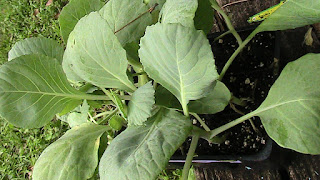Here at the Back Forty Garden, we buy the seedlings: it is more convenient for us, keeping in mind that we have a rather small home garden. These cold weather plants may also be planted from seeds, of course.
The germination time is about 10 days for the three plants that I have selected. The cauliflowers will mature in 120 - 150 days; 75 - 120 days for cabbage; and 100 -130 days for broccoli.
In preparation for these cold weather vegetables, my husband mowed down the field peas after picking them. I turned the soil and removed the largest roots. (The field pea cover crop did a good job of keeping the garden relatively free of weeds.) I added many shovelfuls of mulch from the compost pile and worked into the soil.
All of the cruciferous vegetables need full sunshine and plenty of room to spread their leaves, grow, and develop. I put about a foot and a half between the plants and dug holes that I added garden fertilizer and Ironite. I mixed it around in the hole before I planted the seedlings.
Of the three cruciferous vegetables, the cauliflower requires most attention. It is so exciting to see the snowy curds deep within the plants. Although the cauliflower need full sunshine, it is important to provide the curds with shade when fully exposed to the sun. I simply drape the curd with one of the plants' own leaves. This keeps the vegetable from losing its color and flavor.
The broccoli and the cauliflower freeze well when cut into bite size pieces, blanched, cooled quickly, and bagged. I use the cabbage as needed from the garden and it always fun to make slaw and saurkraut.
Don't forget that the earth would want to feel your bare feet;
the wind would like to play in your hair;
and the sun would like to kiss you ever so gently.
Thank you for visiting my blog.




